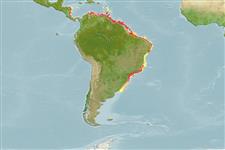Common names from other countries
>
Carangiformes (Jacks) >
Carangidae (Jacks and pompanos) > Scomberoidinae
Etymology: Oligoplites: Greek, oligos = small + Greek, hoplites = armed (Ref. 45335).
More on author: Bloch.
Environment: milieu / climate zone / depth range / distribution range
Ekologi
marina; brackvatten bentopelagisk; djupintervall ? - 40 m (Ref. 9626). Tropical; 16°N - 35°S, 89°W - 34°W
Western Atlantic: Laguna de Caratasca, Honduras to Montevideo, Uruguay.
Size / Vikt / Age
Maturity: Lm ? range ? - ? cm
Max length : 50.0 cm TL hane/ej könsbestämd; (Ref. 5217); common length : 35.0 cm TL hane/ej könsbestämd; (Ref. 5217); publicerad maxvikt: 900.00 g (Ref. 3277)
Adults are found over soft bottoms of the continental shelf, often inshore and in estuaries. Also pelagic and encountered throughout the water column (Ref. 9626). May feed on plankton by ram-filtering. Juveniles feed mainly on planktonic crustaceans and chaetognaths, to a minor extent on benthic crustaceans and polychaetes, besides scales taken from larger fishes (Ref. 30206, 40402). Mature females generally spawn in summer. Eggs are pelagic (Ref. 35237). Marketed mostly fresh.
Life cycle and mating behavior
Maturities | Reproduktion | Spawnings | Egg(s) | Fecundities | Larver
Cervigón, F., 1993. Los peces marinos de Venezuela. Volume 2. Fundación Científica Los Roques, Caracas,Venezuela. 497 p. (Ref. 9626)
IUCN Red List Status (Ref. 130435)
CITES (Ref. 128078)
Not Evaluated
Threat to humans
Harmless
Human uses
Can't connect to MySQL database (fbapp). Errorcode: Too many connections
